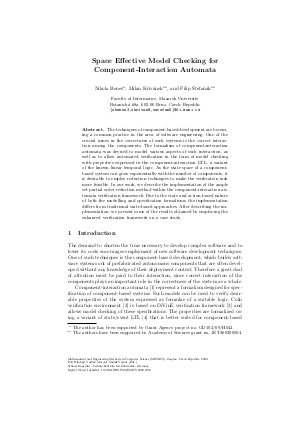Space Effective Model Checking for Component-Interaction Automata
Authors Nikola Beneš, Milan Křivánek, Filip Štefaňák
-
Part of:
Volume:
Annual Doctoral Workshop on Mathematical and Engineering Methods in Computer Science (MEMICS'09) (MEMICS 2009)
Part of: Series: Open Access Series in Informatics (OASIcs) - License:
 Creative Commons Attribution-NonCommercial-NoDerivs 3.0 Unported license
Creative Commons Attribution-NonCommercial-NoDerivs 3.0 Unported license
- Publication Date: 2009-12-15
File

PDF
DROPS.MEMICS.2009.2354.pdf
- Filesize: 339 kB
- 8 pages
Document Identifiers
Subject Classification
Keywords
- Model checking
- component-based systems
- partial order reduction
Metrics
- Access Statistics
-
Total Accesses (updated on a weekly basis)
0Document
0Metadata
Abstract
The techniques of component-based development are becoming a common practice in the area of software engineering. One of the crucial issues in the correctness of such systems is the correct interaction among the components. The formalism of component-interaction automata was devised to model various aspects of such interaction, as well as to allow automated verification in the form of model checking with properties expressed in the component-interaction LTL, a variant of the known linear temporal logic. As the state space of a component-based system can grow exponentially with the number of components, it is desirable to employ reduction techniques to make the verification task more feasible. In our work, we describe the implementation of the ample set partial order reduction method within the component-interaction automata verification framework. Due to the state and action-based nature of both the modelling and specification formalisms, the implementation differs from traditional state-based approaches. After describing the implementation, we present some of the results obtained by employing the enhanced verification framework on a case study.
Cite As Get BibTex
Nikola Beneš, Milan Křivánek, and Filip Štefaňák. Space Effective Model Checking for Component-Interaction Automata. In Annual Doctoral Workshop on Mathematical and Engineering Methods in Computer Science (MEMICS'09). Open Access Series in Informatics (OASIcs), Volume 13, pp. 80-87, Schloss Dagstuhl – Leibniz-Zentrum für Informatik (2009)
https://doi.org/10.4230/DROPS.MEMICS.2009.2354
BibTex
@InProceedings{benes_et_al:OASIcs:2009:DROPS.MEMICS.2009.2354,
author = {Bene\v{s}, Nikola and K\v{r}iv\'{a}nek, Milan and \v{S}tefa\v{n}\'{a}k, Filip},
title = {{Space Effective Model Checking for Component-Interaction Automata}},
booktitle = {Annual Doctoral Workshop on Mathematical and Engineering Methods in Computer Science (MEMICS'09)},
pages = {80--87},
series = {Open Access Series in Informatics (OASIcs)},
ISBN = {978-3-939897-15-6},
ISSN = {2190-6807},
year = {2009},
volume = {13},
editor = {Hlinen\'{y}, Petr and Maty\'{a}\v{s}, V\'{a}clav and Vojnar, Tom\'{a}\v{s}},
publisher = {Schloss Dagstuhl -- Leibniz-Zentrum f{\"u}r Informatik},
address = {Dagstuhl, Germany},
URL = {https://drops.dagstuhl.de/entities/document/10.4230/DROPS.MEMICS.2009.2354},
URN = {urn:nbn:de:0030-drops-23549},
doi = {10.4230/DROPS.MEMICS.2009.2354},
annote = {Keywords: Model checking, component-based systems, partial order reduction}
}
